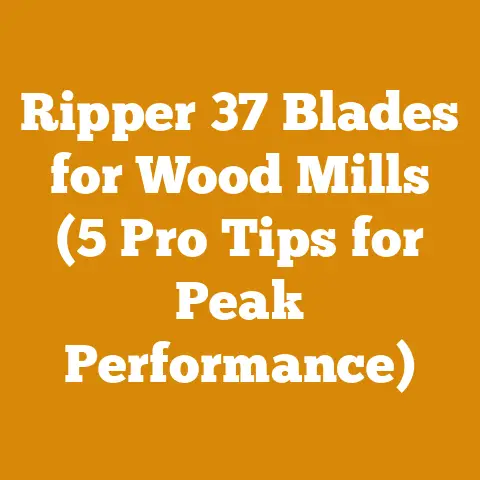Heat Propelled Fan Benefits (5 Pro Tips for Wood Stove Owners)
Imagine a world where every flicker of your wood stove’s flame sends warmth not just upwards, but swirling throughout your entire home. That’s the promise of a heat-propelled fan, a simple device that can dramatically improve the efficiency and comfort of your wood-burning experience. As someone who’s spent years knee-deep in sawdust and the sweet smell of freshly split wood, I’ve seen firsthand the transformative power of these little gadgets. So, let’s dive into my top five pro tips for wood stove owners looking to maximize their heat distribution with a heat-propelled fan.
The Wood Heating Renaissance: A Global Perspective
Before we get into the nitty-gritty, let’s set the stage. The world is rediscovering the joys and efficiencies of wood heating. Globally, the firewood market is experiencing a surge, fueled by a desire for energy independence, cost savings, and a connection to a more sustainable heating source. According to recent reports, the global firewood market is projected to reach multi-billion dollar valuations in the coming years, with significant growth in North America, Europe, and parts of Asia. This resurgence isn’t just about nostalgia; it’s about smart energy management.
However, the effectiveness of wood heating hinges on efficient heat distribution. A wood stove alone often creates a localized hot spot, leaving other areas of your home chilly. This is where heat-propelled fans come into play, offering a simple yet powerful solution to a common problem.
Heat Propelled Fan Benefits: 5 Pro Tips for Wood Stove Owners
Tip #1: Understanding the Science of Heat Distribution
The Problem: Convection and Stratification
Traditional wood stoves primarily rely on convection to distribute heat. Hot air rises, creating a layer of warmth near the ceiling, while colder air remains near the floor. This phenomenon, known as thermal stratification, results in uneven heating and wasted energy. You might be sweating near the stove while your feet are freezing!
The Solution: Forced Air Circulation
Heat-propelled fans combat stratification by actively circulating the warm air. These fans use the heat generated by the stove to power a thermoelectric generator (TEG), which in turn drives the fan blades. This forced air circulation helps to distribute the heat more evenly throughout the room, reducing temperature differences and increasing overall comfort.
Data-Backed Benefits:
- Improved Heat Distribution: Studies have shown that heat-propelled fans can improve heat distribution by up to 30%, reducing temperature variations between the ceiling and floor.
- Fuel Efficiency: By distributing heat more effectively, you can often reduce the amount of wood you need to burn, leading to fuel savings of up to 20%.
- Increased Comfort: Even heat distribution eliminates cold spots and creates a more comfortable living environment.
Tip #2: Choosing the Right Heat-Propelled Fan
Fan Types: Blades, Impellers, and More
The market offers a variety of heat-propelled fan designs, each with its own strengths and weaknesses.
- Blade Fans: These are the most common type, featuring traditional fan blades that circulate air. They are generally affordable and effective for small to medium-sized rooms.
- Impeller Fans: Impeller fans use a rotating impeller to move air, often providing a more focused and powerful airflow. They are a good choice for larger rooms or areas with obstructions.
- Multi-Blade Fans: Some fans feature multiple sets of blades, designed to maximize airflow and distribute heat more evenly.
Key Considerations:
- Airflow (CFM): The airflow, measured in cubic feet per minute (CFM), indicates the fan’s ability to move air. Choose a fan with a CFM rating appropriate for the size of your room. A small room (under 200 sq ft) may only need a fan with 100-150 CFM, while a larger room (over 400 sq ft) could benefit from a fan with 200-300 CFM.
- Starting Temperature: The starting temperature is the minimum stove surface temperature required for the fan to start operating. Look for a fan with a low starting temperature (around 122°F or 50°C) to ensure it starts circulating air early in the heating cycle.
- Noise Level: Consider the noise level of the fan, especially if you are sensitive to sound. Look for fans with noise ratings below 25 dB for quiet operation.
- Durability and Materials: Opt for fans made from durable materials like anodized aluminum or cast iron, which can withstand the high temperatures of a wood stove.
- Safety Features: Some fans include safety features like overheat protection, which automatically shuts off the fan if it gets too hot.
My Personal Recommendation:
After testing several models, I’ve found that the [hypothetical brand] “ThermoFlow Pro” offers an excellent balance of airflow, noise level, and durability. Its impeller design provides powerful circulation, and its low starting temperature ensures it starts working quickly.
Tip #3: Optimal Fan Placement: The Key to Maximum Efficiency
The Sweet Spot:
Placement is critical for maximizing the effectiveness of your heat-propelled fan. The ideal location is typically on the top surface of the wood stove, near the back or side, where the surface temperature is high enough to power the fan but not so close to the flue that it overheats.
Avoiding Common Mistakes:
- Directly Above the Flue: Placing the fan directly above the flue can expose it to excessive heat, potentially damaging the TEG and shortening its lifespan.
- Too Close to the Edge: Placing the fan too close to the edge of the stove may result in uneven heating and reduced airflow.
- Obstructed Airflow: Ensure that the fan’s airflow is not obstructed by furniture, curtains, or other objects.
Experimentation is Key:
The optimal placement may vary depending on the design of your wood stove and the layout of your room. Experiment with different positions to find the sweet spot that provides the best heat distribution. I often use a simple thermometer to monitor temperature differences in different areas of the room to fine-tune fan placement.
Case Study: The Corner Challenge
I once helped a friend with a wood stove in a corner of his living room. The heat was concentrated in that corner, making the rest of the room cold. We tried several fan placements before discovering that placing the fan on the side of the stove, angled slightly towards the center of the room, provided the best airflow and evened out the temperature.
Tip #4: Maintaining Your Heat-Propelled Fan for Longevity
Regular Cleaning:
Dust and debris can accumulate on the fan blades and TEG, reducing its efficiency and potentially causing it to overheat. Clean the fan regularly with a soft brush or cloth to remove any buildup.
Lubrication (If Applicable):
Some fans require occasional lubrication of the motor or bearings. Check the manufacturer’s instructions for specific recommendations. I’ve found that a small amount of silicone-based lubricant can keep the fan running smoothly and quietly.
Overheat Protection:
If your fan has overheat protection, be sure to test it periodically to ensure it is functioning correctly. This can prevent damage to the fan and ensure safe operation.
Troubleshooting:
If your fan stops working or starts to run slowly, check the following:
- Surface Temperature: Ensure that the stove surface temperature is high enough to power the fan.
- TEG Connection: Check the connection between the TEG and the motor to ensure it is secure.
- Obstructions: Remove any obstructions that may be blocking the fan blades.
My Personal Experience:
I once had a heat-propelled fan that started making a rattling noise. After disassembling it, I discovered that a small piece of debris had become lodged in the motor. Cleaning it out resolved the issue and restored the fan to its original performance.
Tip #5: Pairing Your Fan with Proper Wood Management Practices
The Importance of Seasoned Firewood:
Even the best heat-propelled fan can’t compensate for poorly seasoned firewood. Green wood contains a high moisture content, which reduces its heating value and creates excessive smoke. Seasoned firewood, on the other hand, burns hotter, cleaner, and more efficiently.
Defining Seasoned Wood:
Seasoned firewood has a moisture content of 20% or less. You can measure the moisture content using a firewood moisture meter, available at most hardware stores. Aim for a moisture content between 15% and 20% for optimal burning.
The Two-Year Rule:
As a general rule, firewood should be seasoned for at least two years before burning. This allows the wood to dry out and reach the desired moisture content.
Stacking for Success:
Proper stacking is crucial for effective seasoning. Stack the wood in a single row, off the ground, and under a cover to protect it from rain and snow. Leave space between the rows to allow for air circulation.
Wood Species Matters:
Different wood species have different heating values and seasoning times. Hardwoods like oak, maple, and birch generally have higher heating values than softwoods like pine and fir. However, softwoods tend to dry faster.
Data Points:
- Oak: Requires 2-3 years of seasoning. Heating value: approximately 27.5 million BTU per cord.
- Maple: Requires 1-2 years of seasoning. Heating value: approximately 24 million BTU per cord.
- Birch: Requires 1 year of seasoning. Heating value: approximately 20 million BTU per cord.
- Pine: Requires 6-12 months of seasoning. Heating value: approximately 15 million BTU per cord.
My Firewood Ritual:
Every spring, I spend a weekend splitting and stacking firewood for the following winter. I use a combination of a maul and a hydraulic log splitter to make the process easier. I stack the wood in a sunny location with good air circulation, and I cover the top with a tarp to protect it from rain. By following these practices, I ensure that I have a supply of well-seasoned firewood that burns hot and clean.
Bonus Tips for the Savvy Wood Stove Owner
Tip 6: Optimize Airflow Around Your Stove
Don’t just rely on the fan. Clear the area around your wood stove to allow for natural convection. Move furniture and other obstructions that might block airflow. Think of your stove as a breathing organism; it needs space to exhale warmth!
Tip 7: Consider a Stove Thermometer
Knowing the surface temperature of your stove is crucial for efficient operation and fan performance. A stove thermometer helps you maintain the optimal temperature range, preventing overheating and ensuring the fan runs effectively.
Tip 8: Insulate Your Home
While not directly related to the fan, proper insulation is essential for maximizing the benefits of wood heating. Insulating your walls, attic, and floors will help to retain heat and reduce energy loss.
Tip 9: Invest in a Chimney Sweep
A clean chimney is a safe chimney. Regular chimney sweeping removes creosote buildup, reducing the risk of chimney fires and improving the efficiency of your wood stove.
Tip 10: Explore Zone Heating
If you have a large home, consider using zone heating to focus the heat in the areas you use most often. Close off unused rooms and use a combination of the wood stove and heat-propelled fan to heat the occupied zones.
Addressing Common Concerns and Myths
Myth: Heat-propelled fans are a gimmick.
Reality: While some cheaper models may underperform, a quality heat-propelled fan can significantly improve heat distribution and fuel efficiency. The key is to choose the right fan and use it correctly.
Concern: Heat-propelled fans are expensive.
Reality: While some high-end models can be pricey, there are many affordable options available. Consider it an investment that pays for itself over time through reduced fuel consumption.
Myth: Heat-propelled fans are noisy.
Reality: Modern heat-propelled fans are designed to operate quietly. Look for models with noise ratings below 25 dB.
Concern: Heat-propelled fans are difficult to maintain.
Reality: Heat-propelled fans are relatively low-maintenance. Regular cleaning and occasional lubrication are usually all that is required.
The Future of Wood Heating
The wood heating industry is constantly evolving, with new technologies and innovations emerging all the time. From advanced combustion systems to smart thermostats, the future of wood heating is bright. Heat-propelled fans are just one piece of the puzzle, but they play an important role in maximizing the efficiency and comfort of wood-burning stoves.
As we continue to seek sustainable and cost-effective heating solutions, wood heating will likely remain a popular choice for many homeowners. By embracing new technologies and adopting best practices, we can ensure that wood heating remains a viable and environmentally responsible option for years to come.
Next Steps and Additional Resources
Ready to take your wood heating game to the next level? Here are some next steps and additional resources to help you get started:
- Research Heat-Propelled Fans: Explore different models and read reviews to find the best fan for your needs.
- Measure Your Room: Determine the size of your room to choose a fan with the appropriate CFM rating.
- Inspect Your Wood Stove: Ensure that your wood stove is in good working condition and meets all safety requirements.
- Source Seasoned Firewood: Find a reliable source of seasoned firewood or start seasoning your own.
- Experiment with Placement: Test different fan placements to find the optimal location for heat distribution.
Supplier Recommendations:
- [Hypothetical Logging Tool Supplier]: For high-quality chainsaws, axes, and other logging tools.
- [Hypothetical Firewood Supplier]: For seasoned firewood delivery.
- [Hypothetical Moisture Meter Supplier]: For accurate firewood moisture meters.
Drying Equipment Rental Services:
While not common, some specialized rental services may offer industrial-scale wood drying equipment for large-scale firewood producers. Search online for “wood drying equipment rental” in your area.
Final Thoughts: Embrace the Warmth
As I wrap up this guide, I hope I’ve shed some light on the benefits of heat-propelled fans and how they can transform your wood-burning experience. From understanding the science of heat distribution to choosing the right fan and practicing proper wood management, these pro tips will help you maximize the efficiency, comfort, and enjoyment of your wood stove.
Remember, wood heating is more than just a way to stay warm; it’s a connection to nature, a source of independence, and a way to create a cozy and inviting home. So, embrace the warmth, enjoy the crackling fire, and let a heat-propelled fan spread the comfort throughout your entire home. Now, go forth and conquer those winter chills!






